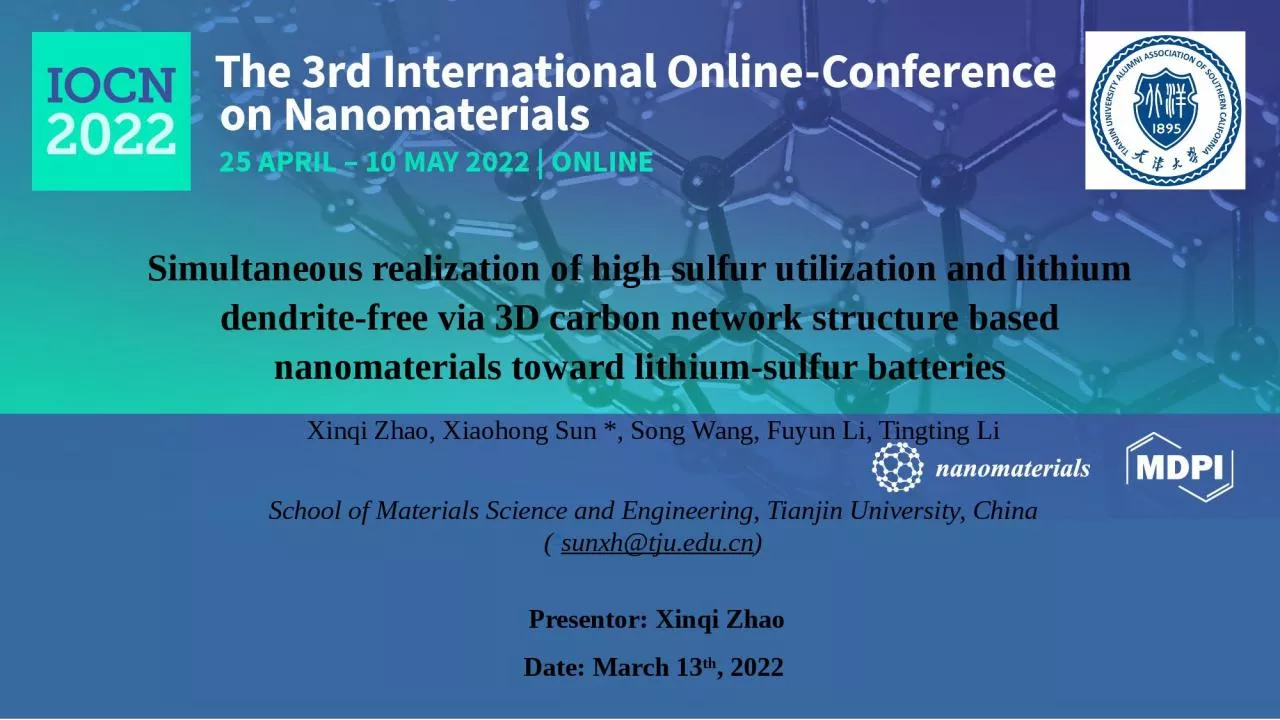

Xinqi Zhao Xiaohong Sun Song Wang Fuyun Li Tingting Li School of Materials Science and Engineering Tianjin University China sunxhtjueducn Presentor Xinqi ID: 1042145
Download Presentation The PPT/PDF document "Simultaneous realization of high sulfur ..." is the property of its rightful owner. Permission is granted to download and print the materials on this web site for personal, non-commercial use only, and to display it on your personal computer provided you do not modify the materials and that you retain all copyright notices contained in the materials. By downloading content from our website, you accept the terms of this agreement.
1. Simultaneous realization of high sulfur utilization and lithium dendrite-free via 3D carbon network structure based nanomaterials toward lithium-sulfur batteriesXinqi Zhao, Xiaohong Sun *, Song Wang, Fuyun Li, Tingting LiSchool of Materials Science and Engineering, Tianjin University, China(*sunxh@tju.edu.cn) Presentor: Xinqi ZhaoDate: March 13th, 2022
2. ABSTRACTThe development of LSBs is largely hindered by the inferior sulfur utilization and uncontrollable dendritic growth. Herein, a hierarchical functionalization strategy of stepwise catalytic-adsorption-conversion for sulfur species via the synergetic of the efficient catalytic host material and light multifunctional interlayer material has been proposed in this work to concurrently address the issues of the dual-side electrodes. The SnS2 micro-flowers embedded into the natural three-dimensional interconnected carbonized bacterial cellulose (CBC) nanofibers is presented as a sulfur host (CBC/SnS2), equipping with numerous catalytic sites for the rapid catalytic conversion of sulfur species. Moreover, the distinctive CBC-based heterostructure conductive network as interlayer material is formed through the lewis acid-base interaction of SnO2/SnS2 heterostructures with uniform natural hydroxyl groups on the BC surface accompanying with the high conductive CNTs (CBC/SOSC), which achieves rapid anchoring-diffusion-conversion of LiPSs, Li+ flux redistributed and uniform Li deposition. LSBs equipped with these two materials exhibits outstanding stable cycling performance, with an ultra-low capacity attenuation.Schematic illustration of LSBs equipped with CBC/SnS2/S cathode and CBC/SOSC interlayer mechanism.
3. RESULTSFigure left: SEM images (a, b) of CBC/SnS2. SEM image (c) of CBC/SnS2/S. TEM image (d), HRTEM image (e, f) of CBC/SnS2 ; SEM images (g) , TEM image (h) and HRTEM image (i) of CBC/SOSC.Figure right: XRD (a, d), Raman curves (b, e) and BET (c, f) of CBC/SnS2 and CBC/SOSC.
4. RESULTSCV curves of CBC/S, CBC/SnS2/S, CBC/SnS2/S@CBC and CBC/SnS2/S@CBC/SOSC at a scan rate of 0.1 mV s-1(a); EIS results (b), rate performance (c), galvanostatic charge/discharge curves (d), cycle performance of different electrodes (e) of different samples; galvanostatic charge/discharge curves of CBC/SnS2/S@CBC/SOSC at various cycles (f); cycle performance of different samples at the current density of 1.5 C (g) CBC/SnS2/S@CBC/SOSC.Digital image of absorption test by CBC (Ⅱ), CBC/SnS2 (Ⅲ) and CBC/SOSC (Ⅳ), and UV-vis spectrum with different samples after immersion in Li2S6 solution for 10 h (a); Sn 3d (c), O 1s (d) and S 2p (e) XPS spectra of CBC/SOSCCV plots of symmetric cells (f); potentiostatic discharge (f) at 2.05 V
5. CONCLUSIONIn summary, we have designed the feasible sulfur host and interlayer based on the natural 3D interconnected network BC material co-applied into LSBs to solve the issues of low sulfur utilization, polysulfide shuttle effect and Li dendrites on the double electrode side. The CBC/SnS2 sulfur host equipped with enormous active sites offers efficient conversion of sulfur and polysulfides, boosting the sulfur electrochemistry, and consequently enabling high utilization of sulfur in particular under elevated loadings. Meanwhile, the CBC/SOSC interlayer can realize the rapid anchoring-diffusion-conversion process of LiPSs through 3D carbon-based heterostructure network attributing to the strong chemisorption of SnO2, the heterointerface of SnO2-SnS2 heterostructure and the efficient catalytic function of SnS2. It can also be used as a facilitator to redistribute the Li+ flux evenly, thereby significantly dissipating the current density and promoting the uniform Li deposition. In addition, the above BC-derived materials with hierarchical porosity profitably buffer the volume change in the working LSBs. Therefore, the CBC/SnS2/S@CBC/SOSC battery maintains an excellent attenuation rate and an impressive discharge capacity under high sulfur mass loading.